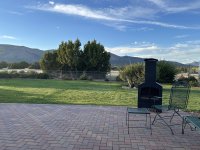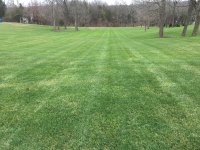Good job. I'm guessing maintaining a lawn in NM is all about irrigation and choosing the right varieties for managing your dry climate.
We are normally pretty wet here in eastern PA, but have a brutal 6 weeks of no rain and 85-95F sun thru all of July and the first half of August. Grasses that favor dry and hot die in our cold winters and wet autumn or spring, but grasses that show high survivability in our winters tend to brown out or even completely die in our July. doh!
Here's mine after the last of the year short mowing, just as it's turning dormant for winter, as you can see from the bit of brown thatch. I mow longer in summer, 4"+ for tall fescue in heat, but take it down near 3" (as shown) for winter to avoid snow mold.
View attachment 827795
I maintain 3 of our 4 acres like a cheap golf course, with the remaining bit always looking rougher due to all the firewood I move and process. All by chemical management, mostly just an adaptive fertilization and pH balancing schedule, I don't get down on my knees to pull weeds.


